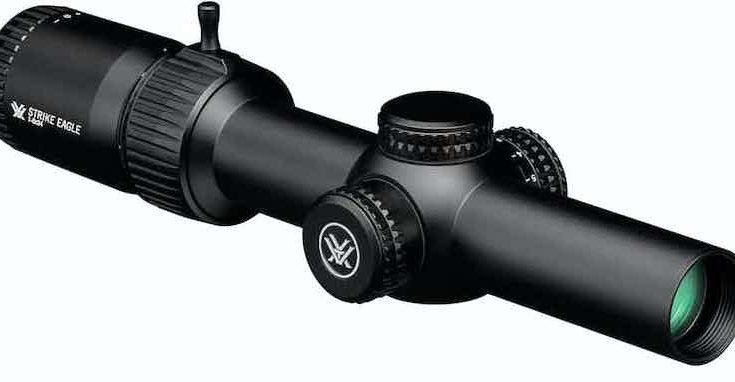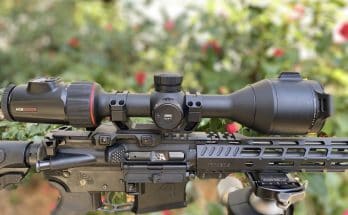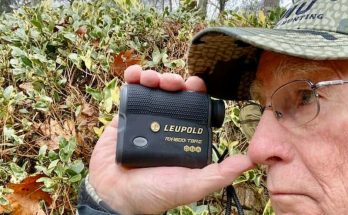The Vortex Strike Eagle 1-6×24 Gen 2 (LPVO) Scope Review is brought to you by The Old Deer Hunters. The Vortex Strike Eagle 1-6×24 Gen 2 in this review is my personal scope that I purchased at retail price. I have also provided information about some of the other LPVO’s I considered from Vortex.
My Vortex Strike Eagle 1-6×24 Gen 2 has a Second Focal Plain Reticle but the Vortex Strike Eagle series is also offered with a First Focal Plain Reticle. The term “second focal plane reticle” refers to the placement of the reticle within a rifle scope. In scopes with a second focal plane (SFP) reticle, the reticle is positioned behind the magnification lenses, meaning its size does not change when you adjust the magnification setting on the scope.
Here’s a breakdown of the key characteristics of a second focal plane reticle:
Reticle Size Doesn’t Change: Regardless of whether you’re zoomed in or out, the reticle maintains a constant size in relation to the target. This is in contrast to first focal plane (FFP) scopes, where the reticle appears to change in size as you adjust the magnification. I chose the SFP reticle because it is much easier to see and use at low magnification.
BDC and Holdover Values: In SFP scopes, ballistic drop compensation (BDC) values and holdover points on the reticle are accurate only at top (6X) magnification setting. I see no issue with the SFP for BDC and hold over because I will always be a max magnification when engaging targets beyond my 200 yard zero range where I would need to use the hold over/windage marks.
It’s important for shooters to understand the characteristics of both second focal plane and first focal plane scopes, as each has its advantages and considerations. The choice between them often depends on the shooter’s preferences and the type of shooting activities they engage in.
The Old Deer Hunters – An On-line Resource For Hunters Since 1999!
Vortex Strike Eagle 1-6×24 Gen 2 (LPVO) Scope Review: Unveiling the Upgrades
The Vortex Strike Eagle 1-6×24 Gen 2 is a versatile optic designed for those seeking a high-quality low power variable optic (LPVO) at an affordable price. This optic offers a magnification range from 1x to 6x, making it suitable for various shooting applications, from quick target acquisition at close ranges to precise shots at extended distances. The scope is also available at 1-8X magnification.
Vortex Strike Eagle 1-6×24 Gen 2 Upgrades:
Throw Lever:
One notable addition in the Gen 2 over the first generation is the throw lever, a threaded lever that enhances magnification adjustments. While it’s removable, I think it a an improvement, providing users with a faster way to changes from 1x to 6x. The throw from 1x to 6x is right about 180 degrees, which is pretty standard for a 1 to 6X scope. It has nice knurling on the zoom ring if you don’t want to use the lever, but for me it is welcomed addition.
Vortex Strike Eagle BDC3 Reticle
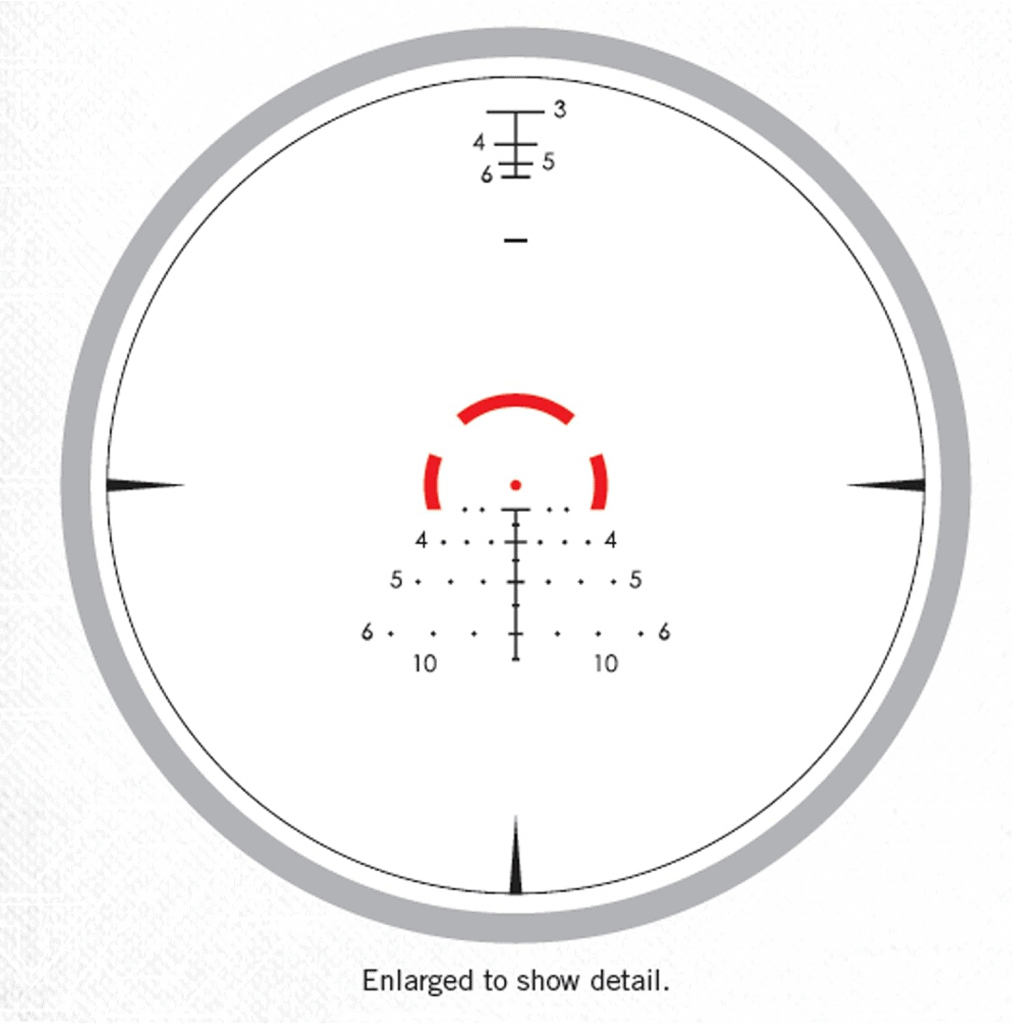
One of the reasons I chose the Vortex Strike Eagle is the reticle. If you ask LPVO users, I think most will tell you the reticle is a key factor when choosing an LPVO scope. The Stike Eagle Gen 2 has the BDC3 reticle, a significant departure from the Gen 1 reticle.
The reticle features a 1 MOA dot at the center for precise aiming, surrounded by a 16MOA horseshoe and hash marks for holdovers at different distances. This reticle is designed for standard 5.56mm ball ammo but also useful for 7.62 NATO/ .308 and other calibers.
Illumination:
The illumination settings range from 1 to 11, with a focus on illuminating only the horseshoe and dot when activated. This design minimizes reticle washout, a common issue in some lower-priced optics. For me, Illumination is critical on a FFP scope, but beneficial with both the SFP reticle than an FFP reticle.
Turrets:
The turrets provide 140 MOA of adjustment and make it easy for zeroing and making necessary windage and elevation corrections. The adjustments are user friendly with audible and tactile clicks. Vortex suggests zeroing the Strike Eagle at 50 yards which will put you about 1.5″ high at 100 yards, zero again at about 200 yards and allow the first holdover hash mark to be on at approximately 300 yards.
Durable Construction:
Like all Vortex optics, the scope has robust construction featuring a single-piece aircraft-grade aluminum tube. Nitrogen purging and O-ring sealing make it shockproof and waterproof, ensuring reliability in various conditions. Of course, it still has the Vortex lifetime warranty.
I think Vortex has really nailed the finish on their scopes and the Strike Eagle is no exception. The finish is not shinny but not dull and looks great with today’s rifles. The turrets are capped so no need to worry about the damaging or moving the adjustment turrets. The zoom ring moves smoothly with just enough friction to keep it put but not hard to move.
The tube is 30MM so it is easy to find a mount for AR-15 rifles or standard rings if you are going to mount it on a carbine with a more traditional stock. The scope weighs 18.5 ounces and is 10.5″ long.
Ocular Focus Ring:
The rear of the optic has a quick focus adjustment ring allowing users to customize the scope for optimal reticle clarity based on individual vision differences. For a single user, this is a set and forget option. If more than one person uses the optic, it is very quick and easy to adjust the reticle for each shooter. It allows you to set the scope to where the reticle is clear for your eyes. Everybody’s eyes are different, so you can back it out, move it in until the reticle is nice and crisp.
Illumination Control:
The side-mounted illumination control offers settings from 1 to 11, with a focus on selectively illuminating the horseshoe and dot in the reticle. The numbers on the control are a little difficult for me to see, but I have old eyes. The brightness control turns pretty easily with clicks for each illumination level.
Battery Compartment:
The CR2032 battery compartment, conveniently located within the left turret along with the brightness control, ensures reliable power for the illuminated reticle. These batteries are common, inexpensive and easy to source.
Windage & Elevation Adjustments:
Each adjustment is in half-MOA increments which is common for low power variable optics. First, in the center, it does have a 1 MOA dot so that you can get a nice precise zero. It is designed to be zeroed at 50/200 yards for the BDC to work. The first hash mark there is the 300-yard hold (for 5.56MM/223). The marks continue down to 4, 5, and 600 yars, with sub-hash mark in between for the 50-yard increments.

I snapped the image above from the user manual because it has so much information in a user-friendly format. It shows you the bullet drop for standard 5.56/223 and 308 service loads. The reticle includes a separate ranging feature at the top of the sight picture. You can range a silhouette size target by bracketing the target and reading the range.
I have not had an opportunity to use the ranging feature yet, but I think it will be easy to use. You can also use the width of the bars for ranging a man-size target.
Reticle Details:
The BDC3 reticle is designed for versatility:
- Center 1 MOA dot for precise zeroing.
- The horseshoe is 16 MOA, about the width of a man at 100 yards.
- Hash marks for holdovers at 50-yard increments up to 600 yards.
- Dots for wind holds at 5, 10, and 15 mph full value.
Performance Notes:
Daylight Brightness: While the optic is bright in low-light conditions, opinions on daylight brightness may vary. I think it is bright enough at the top setting for me in sunlight. The etched reticle allows use in any lighting conditions, even without illumination.
Zeroing Considerations: The optic’s manual recommends a 50-yard zero, but users should be aware of potential adjustments needed for distances beyond 350 yards. After zeroing at 50 yards, I had to make small adjustments at 200 yards for my particular loads. I am shooting 55 grain V-max ammo chronographed at 3000 fps. Confirming the zero at 200 yards is advised for more precise adjustments.
Using the Vortex Strike Eagle 1-6X LPVO
I was really excited about getting my first LPVO. The closest thing I had to this type of optic was a Leupold VX-R 1.25-4X rifle scope. I really liked the Leupold but wanted to try a true 1-6X LPVO. After doing a lot of research and testing several scopes, I settled on the Vortex Strike Eagle 1-6X SFP LPVO.
I tried a couple of other optics. The Sig MSR-BDC6 FFP was my second choice. Fred has one on his Daniel Defense AR that I really liked except for the FFP reticle. It is really a nice scope and you get a lot for your money, but I liked the Vortex reticle design more than the Sig. Of course that is a personal thing and everyone has their favorite. See all the LPVO’s that I researched before buying the Vortex Strike Eagle here in my Best Low Power Variable Optics Review. I included a photo of the reticles used by Vortex, Sig, Primary Arms, Burris, Bushnell, Monstrum and TruGlo.
The first thing I noticed about all the LPVO’s I looked at was the size. They are not compact optics. The foot print is about as large as my 3x9X deer hunting scope and much more bulky with the 30mm tube, cantilever mount and large eyepiece. And even with the large eyepiece, some LPVO’s do not have a large eye box. You have to be lined up well with the scope to see the entire image through the scope.
As far as the reticles are concerned, I really liked everything about the BDC3 reticle. I liked it more than all the other reticle of the other scopes I tried. The illumination of the horseshoe and center dot in the Strike Eagle made it easy for fast shots in close and accurate for longer aimed shots, and using the center dot. The 16MOA horseshoe makes close shots easy and near instant ranging for targets out to 200 yards. If the bad guy is small inside the horseshoe, you know it is time to range him. If you see most or all of him behind the horseshoe you better be sending lead down range.
For me, more training with the LPVO is essential until I become proficient. It is just different than red dot or standard optics. But like anything else in the firearms world, training and practice are the keys to proficiency.
SFP vs. FFP LPVO’s
As far as the SFP vs. the FFP, I am totally into the SFP and find the FFP nearly useless for “MY” needs. I can not see the reticle well with the FFP at low power, especially one that is not illuminated ,and trying to use a BDC of a reticle so small i can hardly see in the first place is a bit absurd. Give me an SFP reticle so I can always see the reticle for close quarters ops, and I will use the ranging and hold over features at 6X.
Vortex Strike Eagle 1-6×24 Gen 2 (LPVO) Conclusion
I really like the Vortex Strike Eagle 1-6×24 Gen 2 and I think it stands out as a valuable addition to the LPVO market. With its upgrades and enhancements over the Gen 1, it offers a great option for shooters seeking versatility, reliability, and improved reticle design. While user preferences may vary, the Strike Eagle Gen 2 presents a commendable choice for those in search of a quality low power variable optic.
The only thing I wish Vortex would add is Shake Awake technology to prevent the battery from running down if not switched off. Knowing me, I better keep a battery handy. The good thing is that the reticle is etched on the glass, so the scope is not dead in the water if the battery is dead.
Overall the Vortex is a great scope. It is clean and everything works as intended. I am pleased with the optic and think it is a good value. Street price for the Vortex Strike Eagle 1-6X on Amazon is $319. If you purchase one of these from Amazon, I may get a small commission.
Vortex Optics Strike Eagle 1-6X Second Focal Plane Riflescope
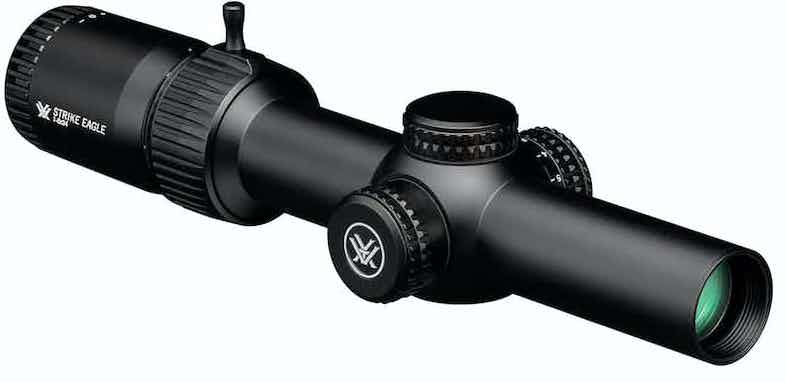
Vortex Optics Strike Eagle Second Focal Plane 1-6X Riflescope $369 at Amazon
| Brand | Vortex |
| Color | black |
| Style | BDC3 |
| Sport | Hunting |
| Item Weight | 18.5 Ounces |
| Material | Aluminum |
| Magnification Maximum | 6 |
| Objective Lens Diameter | 24 Millimeters |
| Magnification Minimum | 1.00 |
| Compatible Devices | Rifle |
- The updated Strike Eagle 1-6×24 is defined by speed and versatility. A true 1x on the low end adapts to a wide range of scenarios, letting shooters rapidly engage targets from point-blank to extended ranges.
- The magnification ring has been updated and now includes a thread-in throw lever, and the magnification indicators can now be seen without coming off the scope.
- The new illuminated BDC3 reticle focuses the shooter’s eye to the target faster and holdovers allow for immediate use out to 650 yards for targets of known distance.
- The fast focus dial on the eyepiece allows for quick and easy reticle focusing. Anti-reflective coatings on all air-to-glass surfaces provide increased light transmission for greater clarity and low-light performance.
- Nitrogen purged and o-ring sealed the for water and fogproof performance. The one piece, aircraft grade aluminum, 30mm tube is shockproof shrugging off recoil and other impacts.
Vortex Strike Eagle 1-6×24 Gen 2 (LPVO) Scope Review – Other Vortex LPVOs
Here are a few other Vortex LPVO’s I researched before buying my Vortex Strike Eagle 1-6X SFP scope. These may suit your needs better than the optic I selected for my shooting requirements.
Vortex Optics Strike Eagle First Focal Plane 1-8X Riflescope
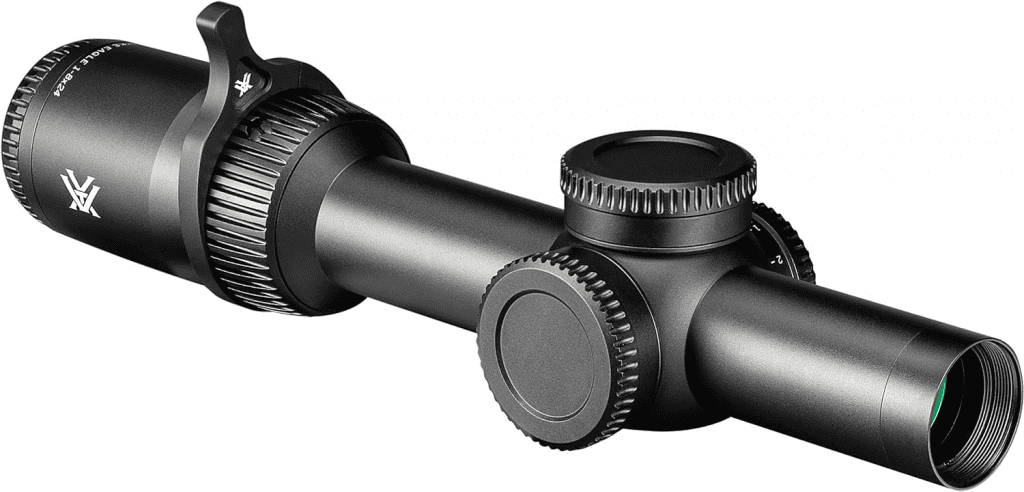
Vortex Optics Strike Eagle First Focal Plane 1-8X Riflescope $599 at Amazon
| Brand | Vortex |
| Color | Black |
| Style | EBR-8 (MOA) |
| Sport | Shooting |
| Item Weight | 2.2 Pounds |
| Material | Aluminum |
| Magnification Maximum | 8 x |
| Objective Lens Diameter | 24 Millimeters |
| Magnification Minimum | 1 x |
| Compatible Devices | Handgun |
- The Strike Eagle 1-8×24 FFP scope gives accurate holdovers at any magnification you’ve been looking for in an LPVO, providing you with the ultimate short to medium-range riflescope.
- The EBR-8 reticle provides true red dot-like performance at 1x and holdovers out to 600 yards, and an included ranging feature in the reticle. With 9 daylight settings, you can dial up illumination to perfectly match the scenario.
- The XD optical system and fully multi-coated lenses deliver a crisp sight picture to pick out targets faster. The included throw lever makes for rapid magnification changes.
- To stand up to getting knocked around, the shockproof, 30mm tube is made of aircraft grade aluminum, and capped turrets keep your zero locked in.
- The scope is nitrogen purged and o-ring sealed for waterproof and fogproof performance. Armortek coatings protect the lenses from scratches, oil, and dirt.
Vortex Venom 1-6×24 Second Focal Plane Riflescope – BDC3 Reticle

Vortex Venom 1-6×24 Second Focal Plane Riflescope – $299 at Amazon
- The Venom 1-6×24 Second Focal Plane riflescope combines speed, performance, and value to meet the demands of entry-level competition use or hunting. The single piece, shockproof, 30mm aircraft aluminum tube is built tough.
- With an XD optical system and fully multi-coated lenses, the Venom delivers clear pictures even in dim light. The second focal plane system ensures an easy-to-see reticle image throughout the entire magnification range.
- An illuminated BDC3 reticle for fast, accurate short- to mid-range target engagements. Use the ranging feature at the top of the reticle to range a silhouette target up to 600 yards.
- Textured tactile turrets and the included throw-lever allow lightning-fast magnification and fine-tune adjustments, even with gloves.
- Nitrogen purged, the Venom brings waterproof and fogproof performance to the field. Armortek coating protects the lenses from scratches and oil.
If you are seeking a reliable optic for defensive training, target shooting, or hunting, I think the Vortex Strike Eagle is a great choice. I chose the Stike Eagle 1-6X, but you may be better served by one of the other Vortex LPVOs. This scope was in my price range, it performs very well and of course the Vortex name and warranty means it will last a lifetime.
To see the other LPVOs I considered, view our Best Low Power Variable Optics (LPVO) Under $400.
Other Reviews By The Old Deer Hunters
Top 10 Best Rifle Scopes For Coyote Hunting For 2024
Best 10 Bedside Handgun Safes 2024
Top 10 Best 22LR Rimfire Rifle Scopes
Best AR-15 Scopes Under $100 for 2023
Best Gun Vise For Gun Cleaning & Scope Mounting
Best 7 Biometric Gun Safes For Rifles & Shotguns Review

